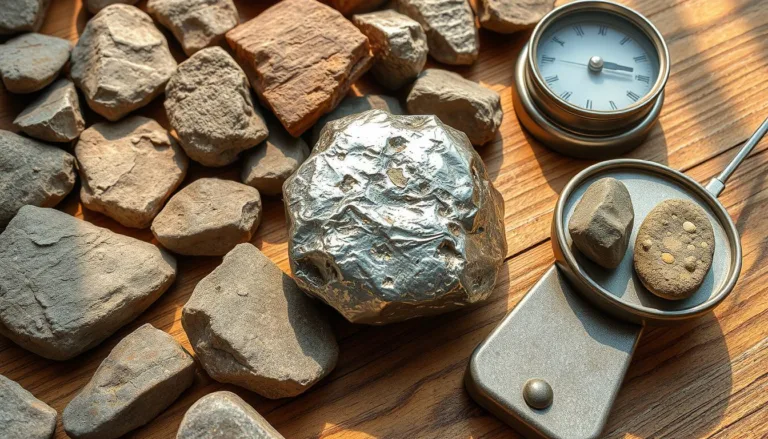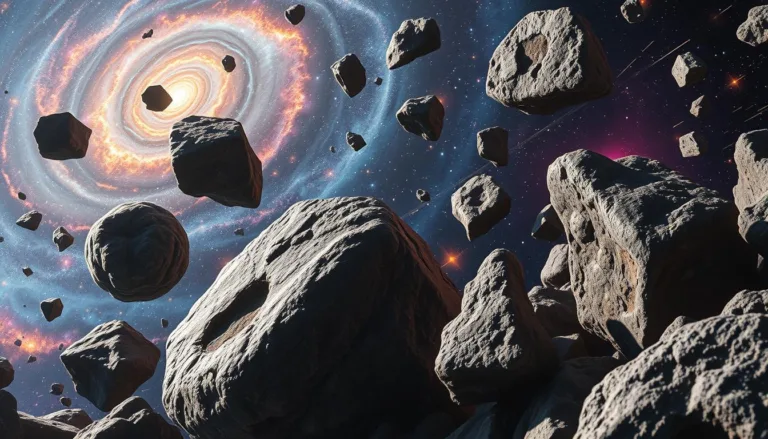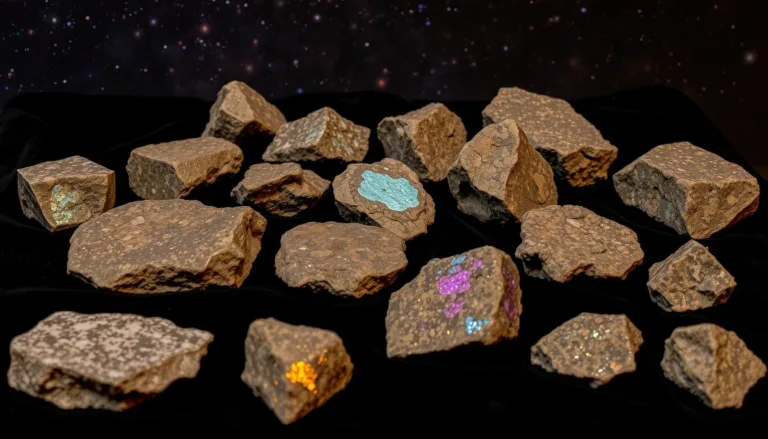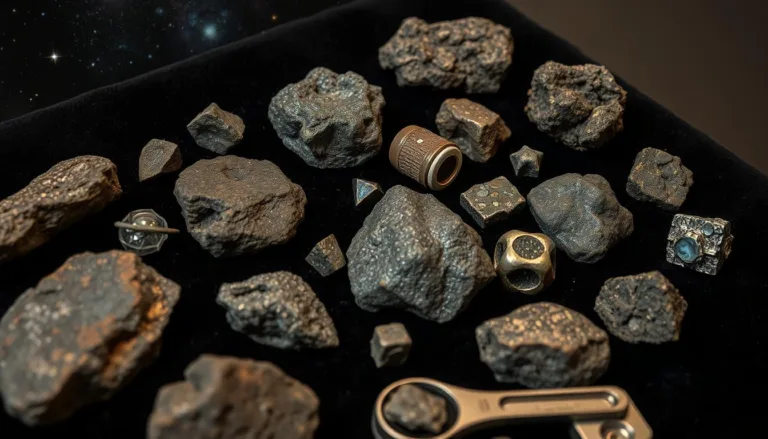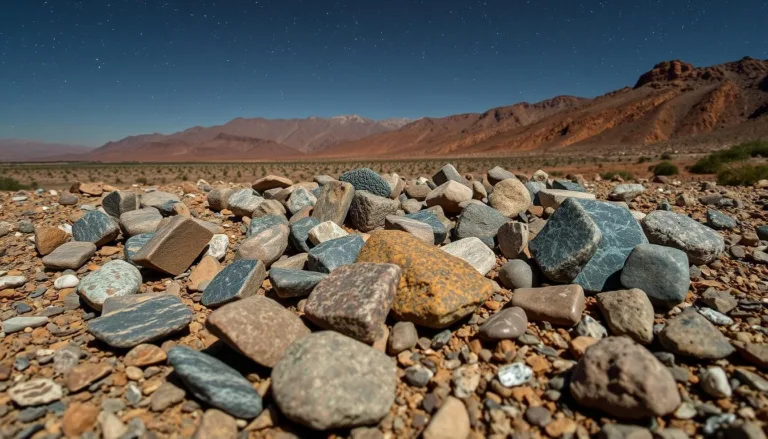We’re excited to explore the world of lunar meteorites. Our goal is to give you a detailed guide on how to spot a lunar meteorite. Knowing how to identify these meteorites is key, and we’ll show you what to look for in a lunar rock analysis.
If you’re curious about identifying lunar meteorites, this article is for you. We’ll cover the essential features and properties of these meteorites. By the end, you’ll know what to look for in a lunar rock analysis and how to identify lunar meteorites.
We aim to offer a clear and concise guide on lunar meteorites. Whether you’re a seasoned collector or just starting out, our article will give you valuable insights. You’ll learn about the key characteristics of lunar meteorites and how to identify them.
Key Takeaways
- Understanding lunar meteorite identification is crucial for distinguishing these meteorites from others.
- Lunar rock analysis is essential for identifying the key characteristics of lunar meteorites.
- Accurate identification of lunar meteorites requires knowledge of their composition and properties.
- Lunar meteorite identification involves analyzing the meteorite’s color, texture, and mineral composition.
- A thorough understanding of lunar meteorites is necessary for approaching lunar meteorite identification and lunar rock analysis.
- Lunar meteorites have distinct features that set them apart from other types of meteorites.
- By following our guide, readers will gain a better understanding of how to identify a lunar meteorite and approach lunar meteorite identification with confidence.
Understanding Lunar Meteorites: From Moon to Earth
Exploring lunar meteorites takes us on a journey from the Moon to Earth. Experts in lunar meteorites have spent years studying these rare rocks. They help us understand how these space rocks travel from the Moon to our planet.
The process of forming and ejecting lunar meteorites is complex. Lunar meteorite classification is a field that requires deep knowledge of the Moon’s geology. By studying these meteorites, researchers learn about the Moon’s composition and its surface changes.
Several factors are key in the formation and ejection of lunar meteorites. These include:
- Impact events on the Moon’s surface
- Space weathering and radiation effects
- Geological processes that shape the Moon’s surface
These factors make lunar meteorites unique and valuable for scientific study.
Physical Properties of Lunar Meteorites
We will explore the physical properties of lunar meteorites. This includes their texture, color, and other distinguishing features. Understanding these properties is key to identifying a lunar meteorite. It’s crucial for lunar meteorite verification and moon rock identification.
Some key characteristics of lunar meteorites include:
- Texture: Lunar meteorites often have a brecciated texture. This is due to intense meteoritic bombardment on the Moon’s surface.
- Color: They can range in color from light gray to dark gray. Sometimes, they have a brownish tint.
- Density: Lunar meteorites are generally denser than Earth rocks. Their average density is around 3.3 g/cm³.
When examining a potential lunar meteorite, these physical properties are important. They help us determine if it’s from the Moon. Lunar meteorite verification and moon rock identification need a detailed analysis of these characteristics. By understanding these properties, we can better identify and authenticate these rare space rocks.
By considering these factors, we can improve the accuracy of lunar meteorite verification and moon rock identification. This helps us understand our Moon and its geological history better.
| Characteristic | Description |
|---|---|
| Texture | Brecciated, fragmented, or glassy |
| Color | Light gray to dark gray, sometimes with a brownish tint |
| Density | Average density of around 3.3 g/cm³ |
How Do I Identify a Lunar Meteorite: Essential Features
Identifying a lunar meteorite needs careful analysis of its features. We’ll show you what to look for, like color and texture, mineral makeup, and fusion crust details. Testing and analyzing lunar samples are key to confirming a meteorite’s lunar origin.
Color and Texture Analysis
When we check a lunar meteorite, we see a variety of colors and textures. These can tell us a lot about where it came from and what it’s made of.
Mineral Composition
The minerals in a lunar meteorite are also important. We look for minerals like olivine, pyroxene, and plagioclase. These are common in lunar rocks. Analyzing these minerals helps us confirm if it’s a real lunar meteorite.
Fusion Crust Characteristics
The fusion crust, formed when the meteorite enters Earth’s atmosphere, is also key. We study its texture, color, and thickness. This helps us see if it matches a lunar meteorite. Testing the fusion crust is part of verifying a meteorite’s authenticity.
- Color and texture analysis
- Mineral composition
- Fusion crust characteristics
By examining these features and doing thorough testing and analysis, we can tell if a meteorite is from the Moon.
Common Misconceptions About Moon Rocks
When we talk about moon rocks, many people get things wrong. It’s easy to confuse them with rocks from Earth. To tell them apart, we need to know what makes moon rocks special.
Some think all moon rocks look the same. But that’s not true. They can look very different, making it hard to tell them apart.
Terrestrial Look-alikes
Earth rocks can look a lot like moon rocks. This makes it tough to tell them apart. Experts use special tests to figure out which is which.
Popular Myths Debunked
Many myths exist about moon rocks. Some say they’re super rare or only found in certain places. But, moon rocks can be found all over the world. By clearing up these myths, we can learn more about moon rocks.

By understanding the myths about moon rocks, we can learn more about them. With careful study, we can make sure we identify moon rocks correctly. This helps us understand more about space rocks.
| Characteristic | Lunar Meteorites | Terrestrial Rocks |
|---|---|---|
| Texture | Varying textures, including breccias and basalts | More uniform textures |
| Mineral Composition | Unique mineral compositions, including feldspathic rocks | Different mineral compositions |
| Fusion Crust | Presence of fusion crust, indicating atmospheric entry | No fusion crust |
Scientific Testing Methods for Verification
Lunar meteorite experts are key in checking if a meteorite is from the Moon. They use many scientific tests to make sure. One important test is lunar meteorite classification, which looks at the meteorite’s minerals and structure.
Experts use both non-destructive and destructive tests. Non-destructive tests include looking at the meteorite, X-ray CT scans, and magnetic tests. Destructive tests take samples and check the chemical makeup with XRF and SEM.
When checking a meteorite, lunar meteorite experts look for several things:
- Mineral composition: Lunar meteorites have minerals that are not found on Earth.
- Isotopic signature: They have a unique isotopic signature that sets them apart.
- Fusion crust: They often have a fusion crust from entering the atmosphere.
These tests help experts confirm if a meteorite is from the Moon. This knowledge is crucial for understanding the Moon’s geology and the solar system’s formation.
Chemical Composition and Mineralogy
We explore the chemical makeup and mineralogy of lunar meteorites. This helps us understand their unique traits. It’s key for verifying lunar meteorites and identifying moon rocks. Lunar meteorites mainly consist of silicate minerals like feldspar, pyroxene, and olivine.
The main elements in lunar meteorites are oxygen, silicon, aluminum, iron, calcium, and magnesium. These elements help prove a meteorite’s lunar origin. Trace elements like titanium, chromium, and manganese also offer clues about the meteorite’s past.
Major Elements Present
- Oxygen: 43%
- Silicon: 21%
- Aluminum: 10%
- Iron: 13%
- Calcium: 9%
- Magnesium: 6%
Crystal Structure Studies
Studying the crystal structure of lunar meteorites is crucial. It tells us about the meteorite’s past conditions. This info is vital for identifying and verifying moon rocks.
In summary, the chemical makeup and mineralogy of lunar meteorites are essential for their identification. By examining major and trace elements, and the crystal structure, we can confirm a meteorite’s lunar origin.
| Element | Percentage |
|---|---|
| Oxygen | 43% |
| Silicon | 21% |
| Aluminum | 10% |
| Iron | 13% |
| Calcium | 9% |
| Magnesium | 6% |
Professional Authentication Process
Verifying lunar meteorites’ authenticity is crucial. This means lunar meteorite testing and lunar sample analysis to check their origin and makeup. We team up with certified labs for this task. They use advanced tools and methods to study the meteorite’s minerals, structure, and chemical makeup.
The steps in this process include:
- Initial look and sorting
- Detailed lunar sample analysis with X-ray fluorescence and scanning electron microscopy
- Comparison with known lunar meteorites and Earth rocks
- Checking the meteorite’s ownership history
This thorough process ensures lunar meteorites are accurately identified and valued. It prevents mistakes and fraud. It also helps us learn more about the Moon’s geology and the solar system’s formation. Through lunar meteorite testing and lunar sample analysis, we uncover the mysteries of these rare space rocks.
Distinguished Features from Other Meteorites
To figure out if a meteorite is from the Moon, we must know what makes it different. When looking at how do i identify a lunar meteorite, we need to check its makeup, texture, and special traits.
Lunar meteorites have unique qualities that make them stand out. Some of these include:
- High iron and magnesium content
- Presence of certain minerals, such as olivine and pyroxene
- Unique texture and structure, resulting from the meteorite’s formation on the Moon
Understanding these traits helps us better identify 
It’s important to remember that lunar meteorites are rare. Their identification needs careful study and analysis. If you think you’ve found a lunar meteorite, it’s key to talk to experts to confirm it’s real.
| Feature | Description |
|---|---|
| Composition | High iron and magnesium content |
| Minerals | Presence of olivine and pyroxene |
| Texture | Unique texture and structure |
Legal Considerations and Ownership Rights
When we talk about lunar meteorites, we must think about the legal side. Lunar meteorite experts need to know the rules about collecting, selling, and owning these meteorites. It’s also key to understand how they are classified.
The laws around lunar meteorites are complex. In the United States, there are specific rules about owning and selling meteorites, including those from the moon. We also have to follow guidelines from groups like the International Meteorological Organization.
International Regulations
International rules are important for collecting and selling lunar meteorites. The Antarctic Treaty, for example, controls taking meteorites from Antarctica. This is because many lunar meteorites come from there. We also need to look at the rules from the United Nations Committee on the Peaceful Uses of Outer Space.
Collection Guidelines
It’s crucial to follow the right steps when collecting lunar meteorites. This means documenting, storing, and handling them correctly. Experts must also know about the dangers of handling meteorites, like contamination and damage.
| Regulation | Description |
|---|---|
| Antarctic Treaty | Regulates the removal of meteorites from Antarctica |
| United Nations Committee on the Peaceful Uses of Outer Space | Regulates the use of outer space, including the collection of lunar meteorites |
Working with Lunar Meteorite Experts
We know how key it is to team up with lunar meteorite experts. They offer insights and help in the lunar meteorite verification process. This is crucial for identifying and confirming moon rocks.
Experts are essential for the accuracy of moon rock identification. This is vital for collectors, researchers, and institutions.
Working with lunar meteorite experts brings many benefits. They have the knowledge and experience to guide us. They help us through the lunar meteorite verification process.
This process involves tests and analyses to confirm a moon rock’s authenticity. Their expertise is key to avoiding misidentification and ensuring the moon rock is real.
Some key benefits of collaborating with lunar meteorite experts include:
- Access to specialized knowledge and equipment
- Improved accuracy in moon rock identification
- Enhanced understanding of the lunar meteorite’s history and significance
By working with these experts, we can appreciate lunar meteorites more. We ensure our collections or research are based on accuratelunar meteorite verificationandmoon rock identification.
Conclusion: Ensuring Authentic Lunar Meteorite Identification
We’ve learned a lot about lunar meteorites. We know what to look for and how to test them. This helps us make sure that lunar meteorite samples are real.
Lunar sample analysis is key to telling real lunar meteorites from fake ones. We look at color, texture, minerals, and fusion crusts. Each detail tells us if it’s from space.
Working with experts and certified labs helps us check samples. This keeps our lunar collections safe and valuable. It also helps us learn more about the Moon.
The story of lunar meteorites is amazing. From the Moon to us, it shows the universe’s beauty. Learning to identify them properly lets us appreciate the Moon and its secrets more.


